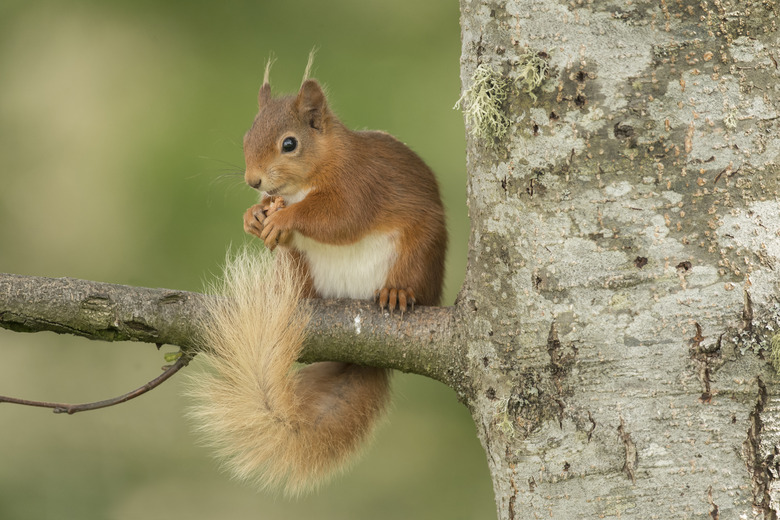Why Do Squirrels Squawk In Trees?
Birds aren't the only animals calling from trees. You may have been scolded by a squirrel without even recognizing it. Chattering noises might sound like some kind of bird, and squirrels can make a screeching noise similar to a bluejay. You might hear an alarm call, raised because of the presence of an intruder — which is you. Other calls for different purposes are much quieter. The calls aren't discussions between squirrels, they're one-way signals.
Noisy Alarm Calls
Noisy Alarm Calls
Squirrels are on the lookout for threats from above and below. When they spot a predator like a cat or a hawk, they'll make a series of barking alarm calls. Dr. Robert S. Lishak recorded squirrels on the Auburn University campus and categorized their calls. He describes a low-intensity "buzz" of quick notes emitted from the nostrils. A "kuk" is a short barking sound repeated several times, followed by a "quaa," which is a longer version of a kuk. Dr. Lishak distinguishes between these two calls by duration: A quaa is a kuk lasting for more than 0.15 seconds. A "moan" is a steady call that begins slowly.
Angry Aggression Signals
Angry Aggression Signals
Squirrels establish and defend home territories that contain their food sources. In the case of American red squirrels, the food sources are conifer trees with their seed-laden cones. Researcher Helene Lair at the Université Laval in Canada describes red squirrels warning potential intruders with rattles and screeches. The rattles appear to advertise the defending squirrel's presence, and the screeches convey a threat to the intruding squirrel. Lair interprets a barking call as a signal to another squirrel to reveal its intentions.
Crying Hunger Calls
Crying Hunger Calls
Richard W. Thorington, Jr. of the Smithsonian Department of Vertebrate Zoology describes sounds made by baby squirrels, varying by their age. They use these calls to summon their mothers. They can squeak by three days of age, growl by three weeks and by four weeks they can emit short screams. Thorington and Lishak describe a "muk-muk" call as a quiet sound a little bit like a puffing noise. You're not likely to hear it coming from a nest high in a tree, but baby squirrels use it to softly call their mother to give them a feeding.
Subtle Mating Calls
Subtle Mating Calls
Lishak and Thorington also describe the muk-muk call as used by the male squirrel to signal interest in mating with a female. It's an imitation of a baby squirrel, intended to signal that the male squirrel is not presenting a threat to the female. It's very different from the screeches of a territorial conflict. You might hear it when aroused squirrels are chasing each other around in the trees.
Cite This Article
MLA
Silbajoris, Alex. "Why Do Squirrels Squawk In Trees?" sciencing.com, https://www.sciencing.com/squirrels-squawk-tree-10057973/. 13 March 2018.
APA
Silbajoris, Alex. (2018, March 13). Why Do Squirrels Squawk In Trees?. sciencing.com. Retrieved from https://www.sciencing.com/squirrels-squawk-tree-10057973/
Chicago
Silbajoris, Alex. Why Do Squirrels Squawk In Trees? last modified March 24, 2022. https://www.sciencing.com/squirrels-squawk-tree-10057973/
